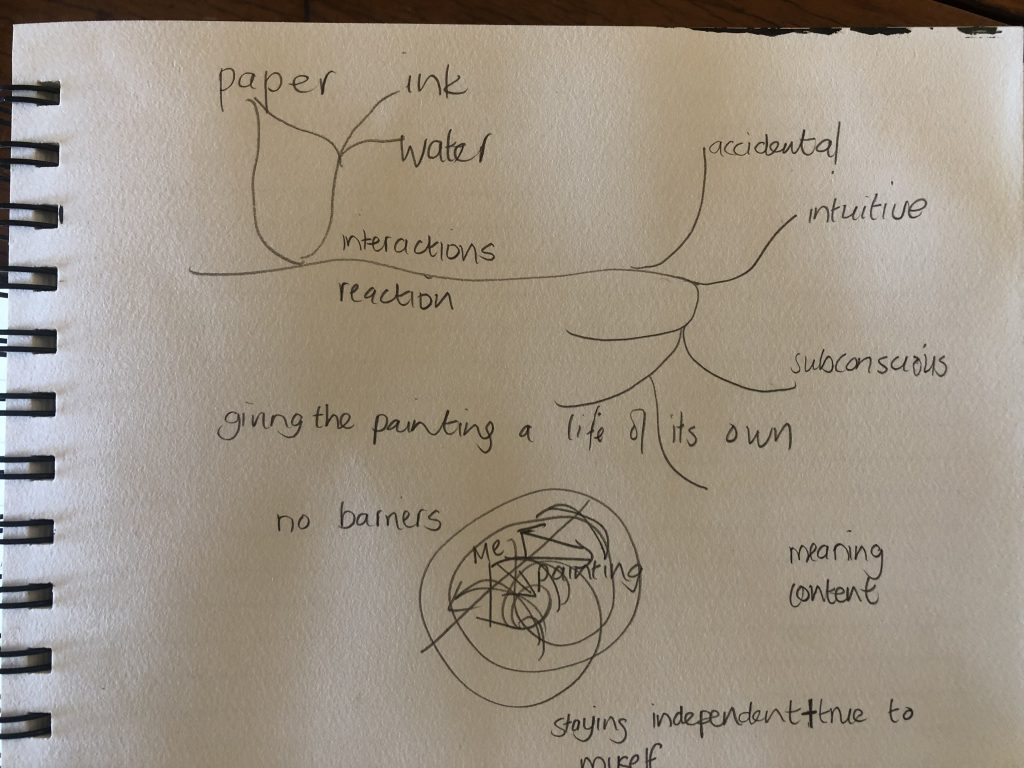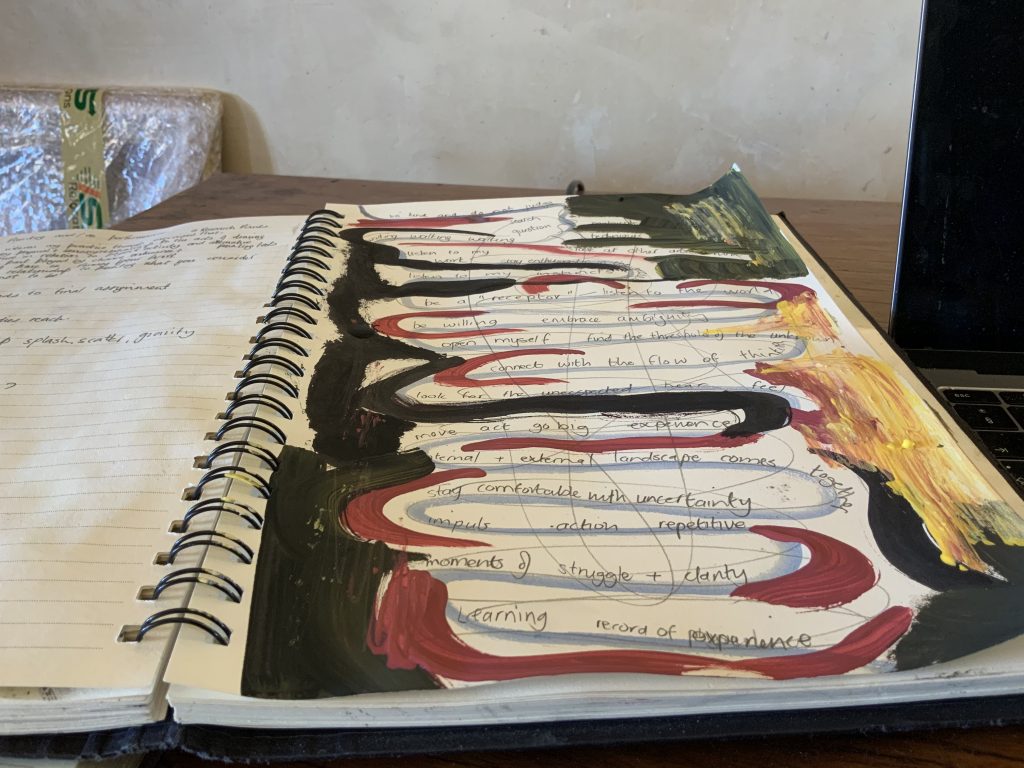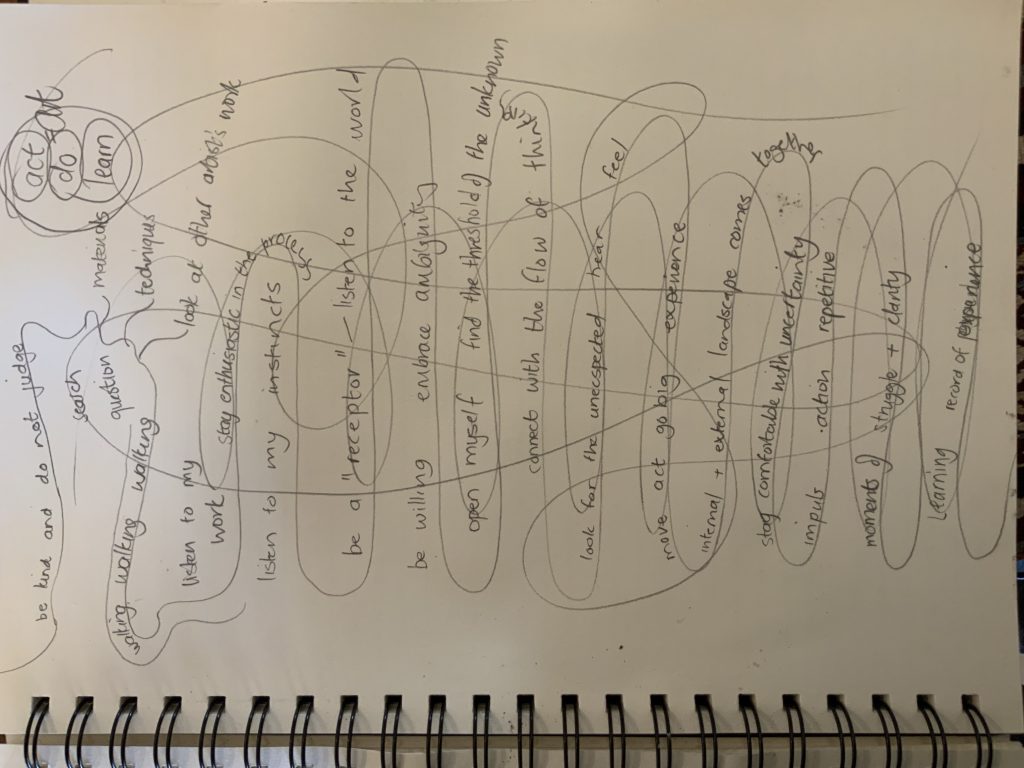Exercise 1.2. Mapping/diagram
Create a series of maps or flow diagrams that enable you to reflect on the processes involved in making the studies from exercise 1 and 1.1. The aim is to reflect on your explorations in ways that allow you to represent your process and its outcomes in a free flowing, visual and spatial form. Try to reflect the movements you made physically in the movement of the map/diagram.
Reading point: Not Knowing in talking and Making, Rebecca Fortnum
I find myself at a challenging place: How will I show a reflection about the learning, movements, and gestures I explored, when I many a time find myself completely lost in the making without a camera near me to capture my sometimes very erratic work process? There were times in the different attempts that I did not know what to expect in terms of outcome, juged it and wanted to tear it up, then the blissful moments where I liked what happened, but in a moment with another gesture,it lost that form/compositional aesthetic I enjoyed earlier. Making flow lines in my sketchbook with words about my experience whilst making below shows language of thinking and making -thinking flowing continuously whilst working like a line on the move. The gestural movements opens ideas of making as one can find a great personal rhythm in these movement and feel directly in contact with the work. I also think the more you continue on this style of working, the less accidental the works will become, learning process. With this in mind I ask myself about process versus context.


I also know that one attempt leads to another, becoming more intuitive. I considered the exercises as a form of provocation, as with walking. I wanted to be aware of anything that happens, be open to new outcomes, and focus on movement. In the article (Reading point, above mentioned) Fortrum refers to studio work as to where creative work is made, epiphany type moments of a breakthrough, and also own conceptions being pushed to consider the “possible and probable”. She refers to painter Beth Harland who described her approach as moving towards the unknown, and here the artist quoted Foucault when she writes that he called it “working at the edge of an un-thought, slowly building a language in which to think it.” I looked at the work of Harland and the following on her website caught my attention: “Research interests include: pictorial modes of address and spectator experience; painting and digital imaging; notions of temporality in art….” I think that exploring my walking I find myself very much in a research interest which I want to translate into a language. I joined an OCA reading group recently and was introduced to Tim Ingold and learning that he views maps drawn by humans as a gestural re-enactment through lines of movement of journeys actualy made (Ingold, 2007:84) In this embodied performance we find a kind of knowledge – our eyes follows the lines of the map as it would follow a gesture.
I learnt that Deleuz and Guittari used maps to play a discreet part as rhizomatic ways of escaping representation: can I look at map making in my walking also as oriented toward experimentation? For me they do not reproduce; they have multiple entryways; they are open and detachable. (Deleuze and Guattari 1987, 12)

I hope explore this in my Parallel project.
Below is an attempt in my sketchbook with ink and water where my finger-markings appealed to me as a way to understand how the medium is moved and imprints can be manipulated. I considered using my piano to develop the work and after a few failed attempts at putting paper on the notes as well as inside the piano, on the hammers and strings, I saw it as a failed experiment. I tried cut paper on the notes – but the movement of the paper during my playing on the notes, made the experiment unstable and I considered trying it with paint on my fingers to risky – damaging the piano.
Looking at work of artist Bianca Severijns: The following was taken from her website:
“The material is full of possibilities and begs to be transformed: you can cut, fold, weave, tear, crumble, roll, paste and layer it. Paper speaks to me, the sound when I tear it, the touch, the smell, the texture…it’s mesmerizing. Still today, I discover new things, develop new techniques and explore new paper-related elements. The play with paper is endless.Unfortunately, paper as an art medium is still pushed into the category of craft or applied decorative art despite being accepted as contemporary art when used by grand masters like Picasso and Matisse. Rather than regarding paper as merely a support to draw or paint on, I treat paper as material that can be manipulated in new and unusual way. You can listen to paper because it has a memory, resistance, textures, limitations, a charm and so much more.”
I was captured by the ‘Lyric Suite‘ a 1965 series of works with ink on rice paper by Robert Motherwell. Apparently, he produced 560 ink drawings after he bought 1000 sheets of rice paper, called Dragons and Clouds. It seems this was an intense period where he would make between 10 and 50 a day. He later said that some of the works were made in seconds, not minutes, and were done whilst listening to Alban Bergs music. What I found particularly interesting is that he experienced, as this process continued, how the rhythm of his writs became freer and broader and unselfconscious and this he saw the process of making as ‘unadulterated automatism’ ( He referred to his strokes as violence, but without tearing the paper. It remained incomplete as he stopped after a friend died unexpectedly. I love the blobs moving into, around, or just bleeding at its fringes. I see islands and cartography in these works as well as the satellite images of weather patterns which have been a fascination lately for me. It is seen as contemplative works. I read that “for Motherwell, modern meant the practice of a universal art built around an emphasis on materiality and the momentary, freeing the maker and the made of historical and cultural responsibilities.” (Hyperallergic.com, December 2014)
Bibliopgrpahy
Kean,Tim 2014 Absolutely Modern:Robert Motherwell on Paper, Hyperallergic.com Dec13, 2014
McKenzie, Janet, 2011 , Cornish Sam, Robert Motherwell: Works on Paper (London:Bernard Jacobson Gallery, 2011 pp42.43
